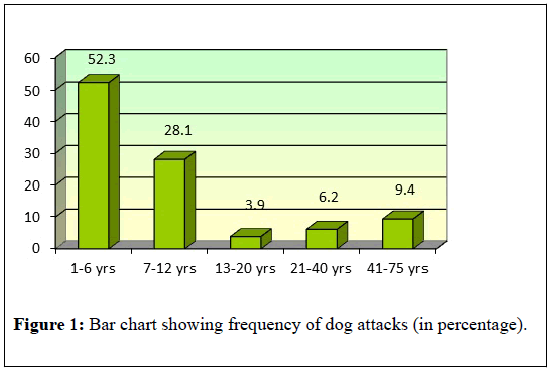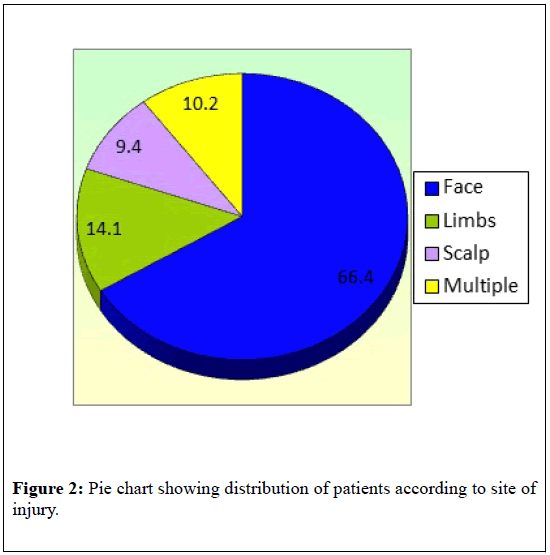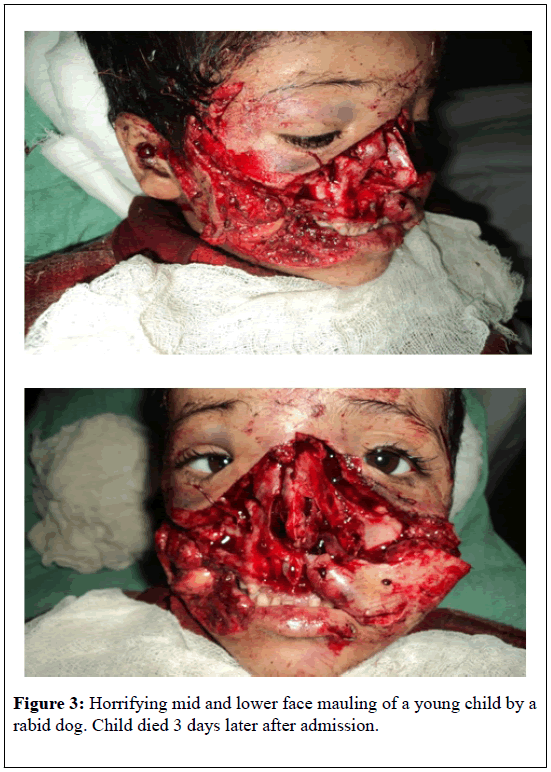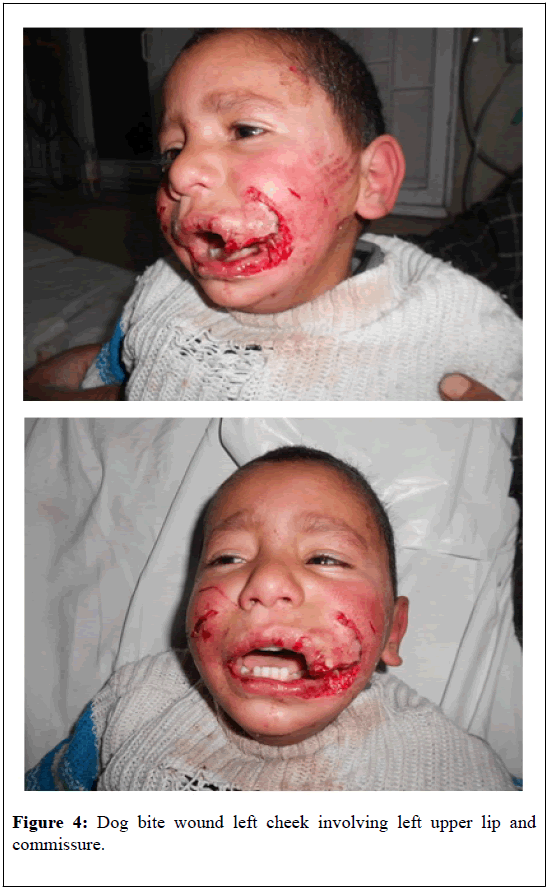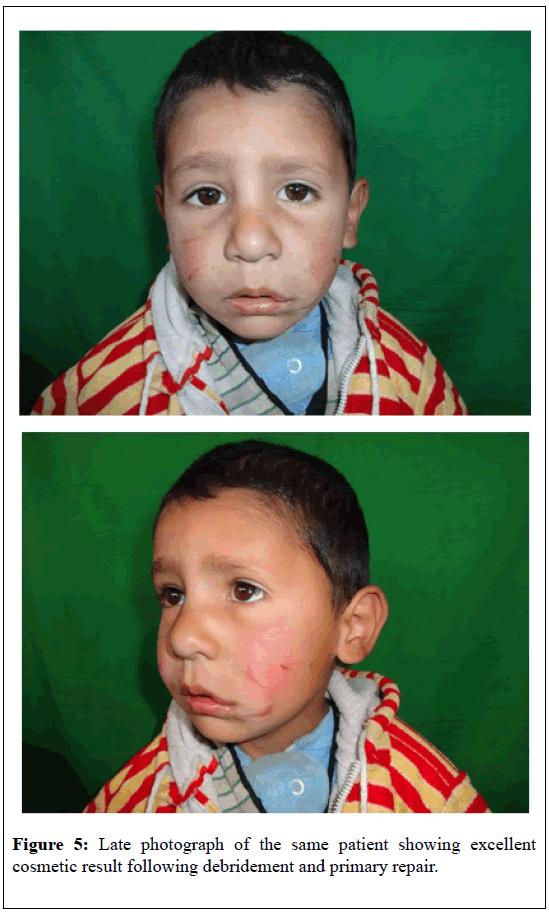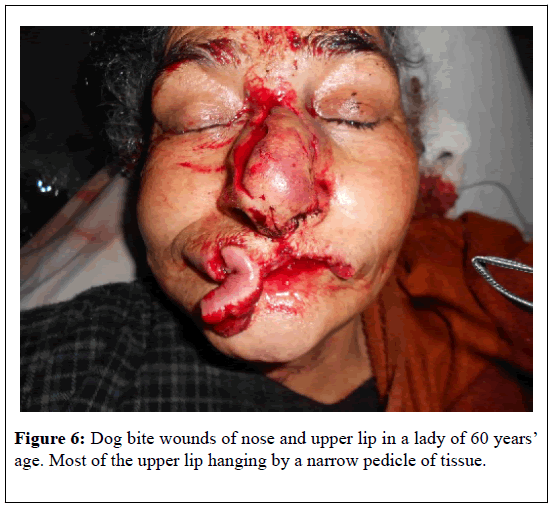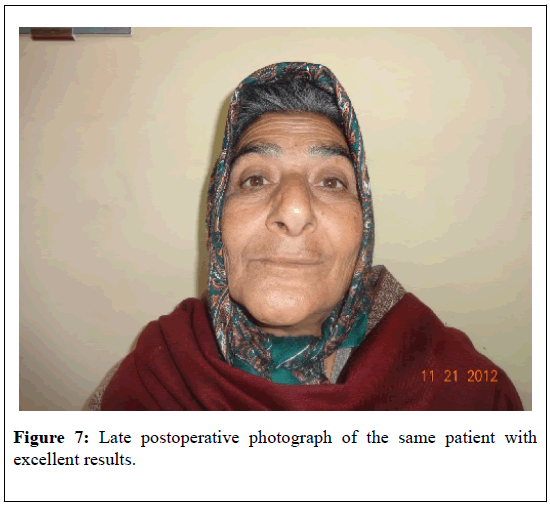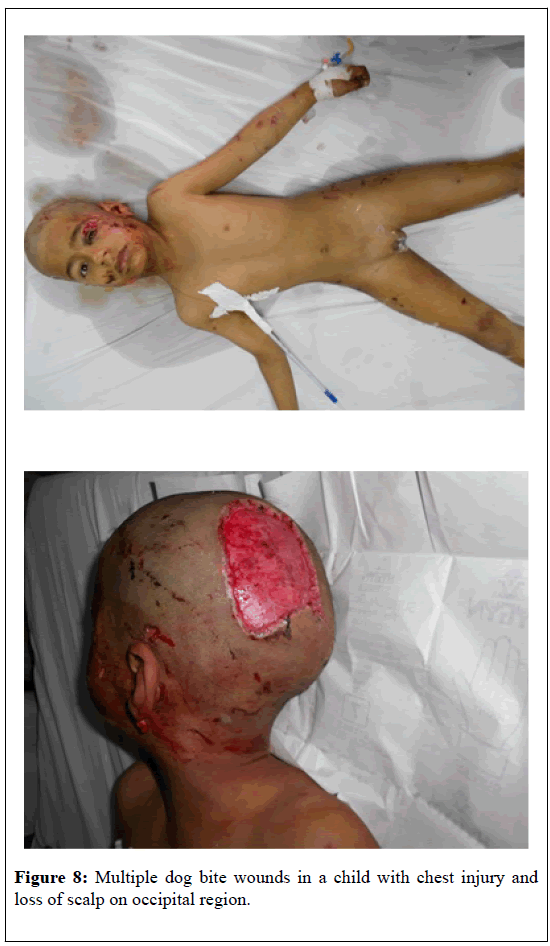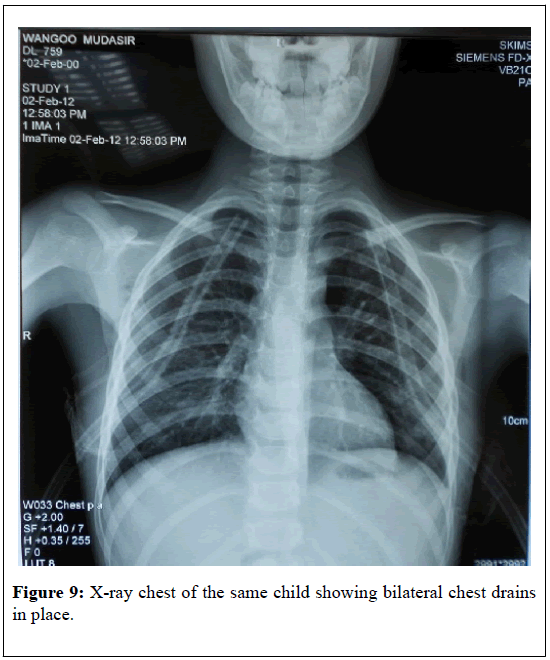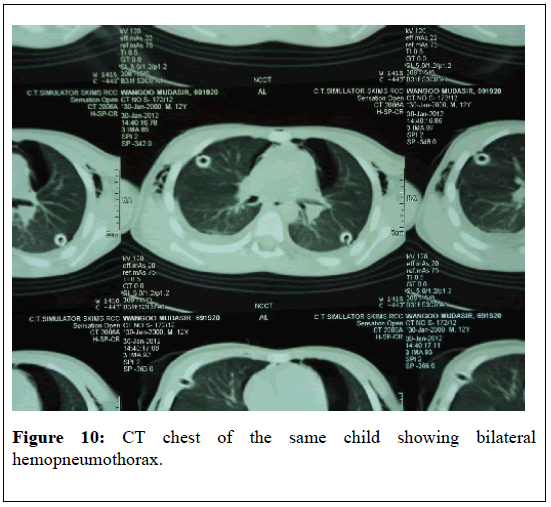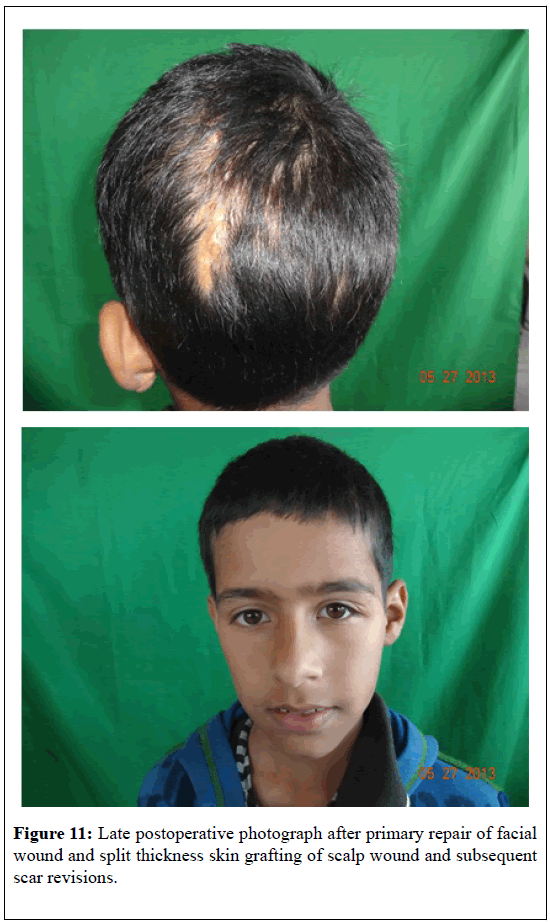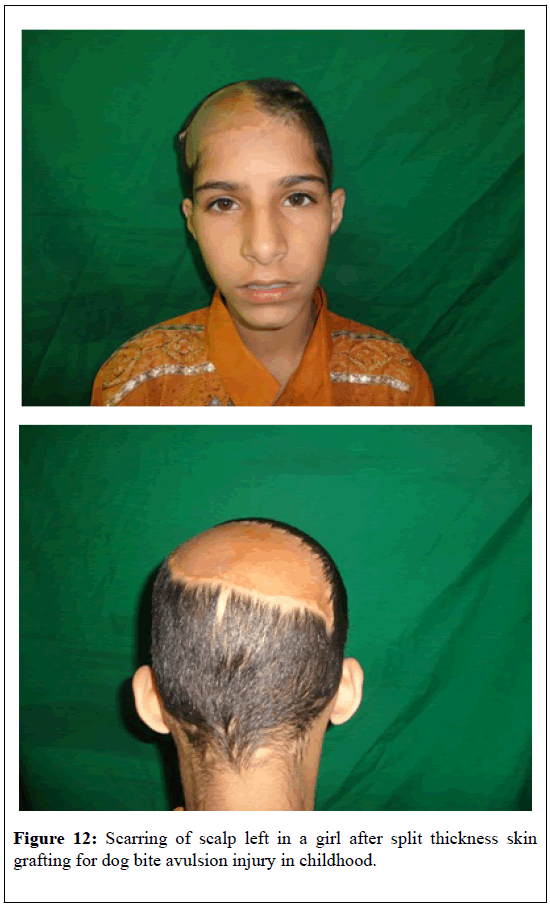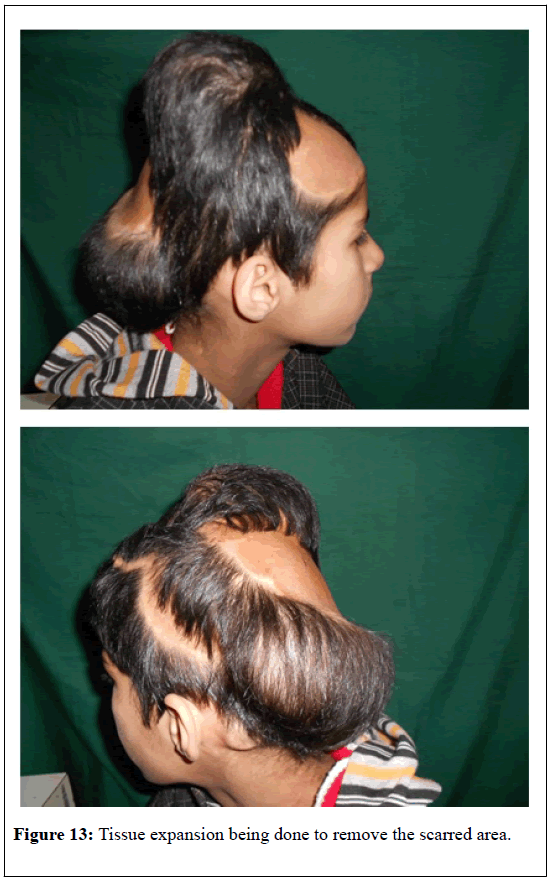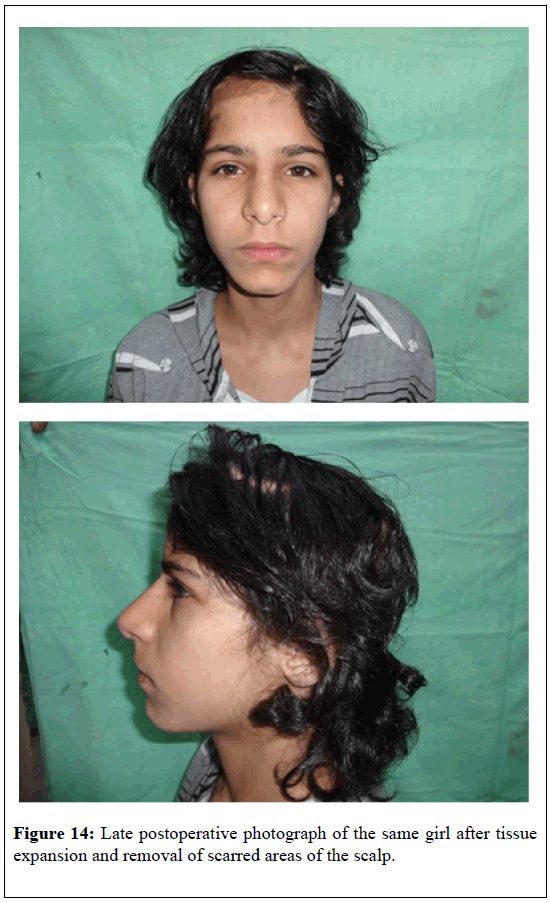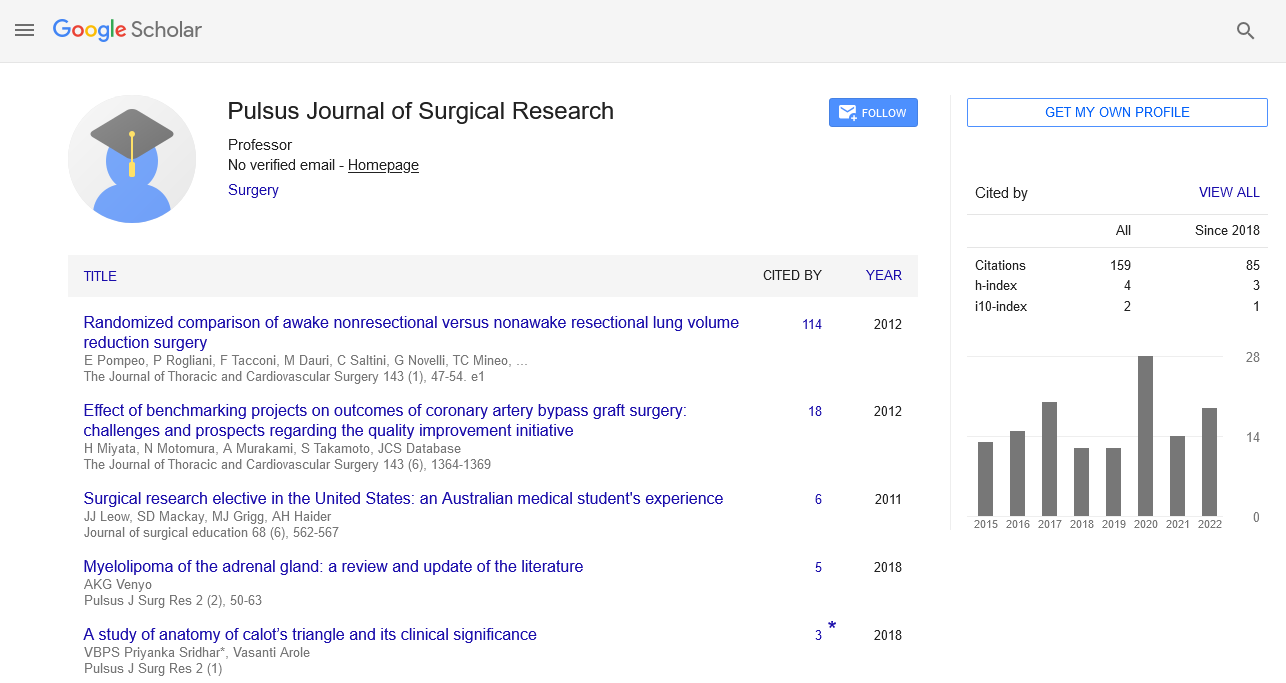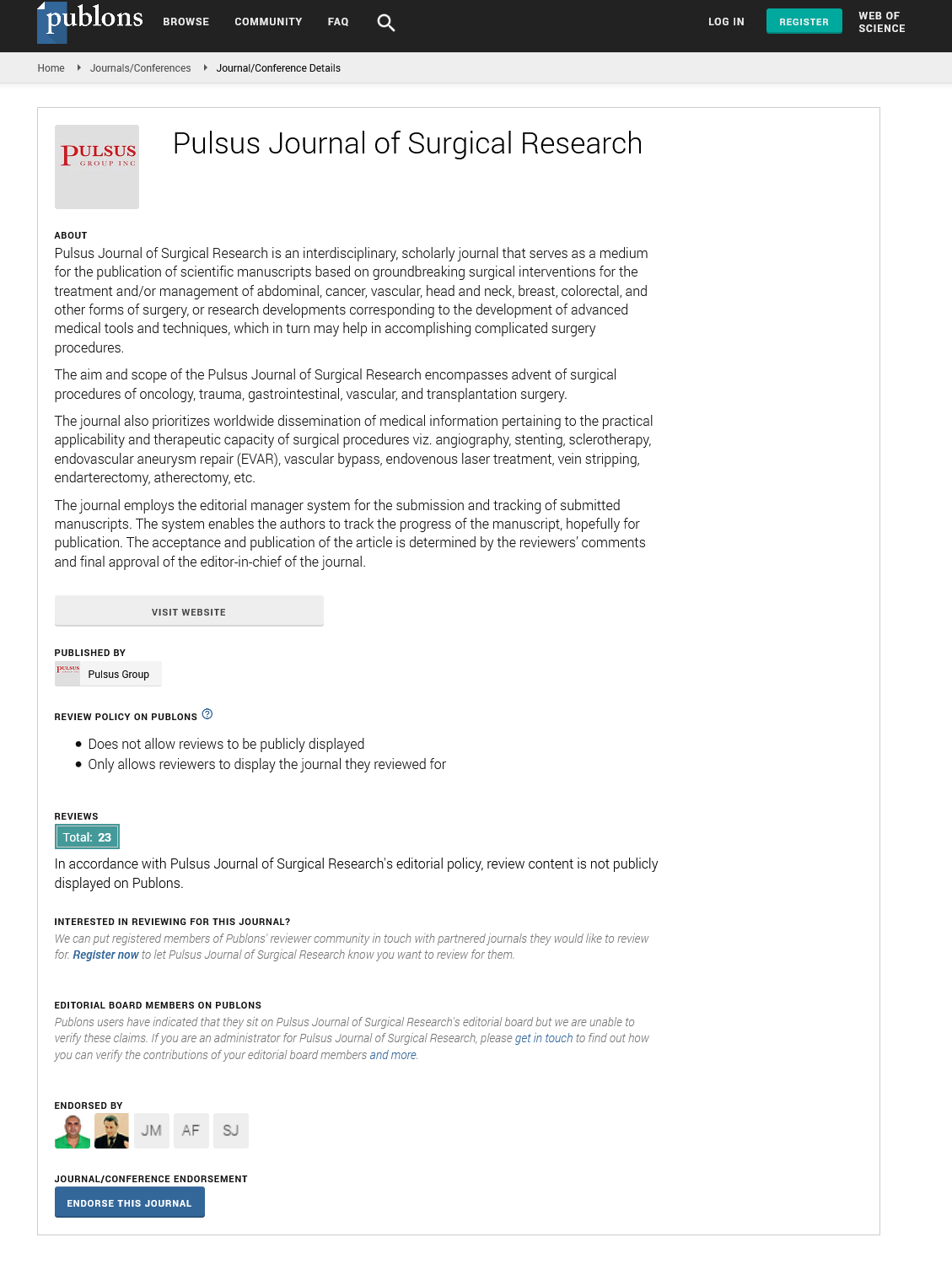Analysis of Dog Bite Injuries in Kashmir
2 Plastic and Reconstructive Surgery, Sher-I-Kashmir Institute of Medical Sciences, Soura, Srinagar, India, Email: uvish@yahoo.com
3 Darul Aloom University, Riyadh, KSA, Email: uvish@yahoo.com
Received: 13-Sep-2017 Accepted Date: Oct 14, 2017; Published: 23-Oct-2017
Citation: Lu J, Jia Z, Zhang J, Kong CJ. Targeted cyst-deroofing for symptomatic polycystic liver disease . Pulsus Journal of Surgical Research. October-2017;1(1):10.
This open-access article is distributed under the terms of the Creative Commons Attribution Non-Commercial License (CC BY-NC) (http://creativecommons.org/licenses/by-nc/4.0/), which permits reuse, distribution and reproduction of the article, provided that the original work is properly cited and the reuse is restricted to noncommercial purposes. For commercial reuse, contact reprints@pulsus.com
Abstract
Objectives: This study focuses on the epidemiological profile, mechanism, circumstances and management of dog bite injuries in a state of a developing country.
Methods: One hundred twenty eight patients of dog bite injuries were studied over a period of 2½ years (between January 2011 to June 2013). A detailed history about the circumstances of the event was taken and thorough examination of the patients was performed. This was followed by proper and timely treatment of the patients as per the standard management guidelines.
Results: A total of 128 patients (mean age 13.6 years) of dog bites accounted for 1% of all trauma cases until presentation. Most of the patients (52.3%) were in the age group of 1-6 years. Males accounted for 66.4% of patients. Most of the dog bite incidents occurred during December to March. 65.5% patients were from rural background. Face was the commonest affected organ by the dog bite and was the affected site in 45.3% children aged between 1-6 years. Limbs were most commonly affected in older age group. Most of the dog bite incidents were unprovoked. Majority of the patients (96.1%) had around 1-5 dog bite wounds all over the body. Lacerated wounds were the most common type of wounds. 84.4% patients had WHO class III wounds. In 70.3% of patients, debridement with primary repair of the wound was done with excellent cosmetic results and minimal complication rate.
Conclusion: Dog bite victims mostly are children. Majority are nonfatal. Dog bite incidents can be decreased or prevented if the number of street dogs in our state is reduced, as this being the prime reason for the increasing dog bite incidents. Proper wound management results in excellent cosmetic outcome especially in children.
Keywords
Dog bite; Debridement; Primary repair
Introduction
Biting of humans by domestic animals, especially by dogs, is common injury which is associated with high risk of bacterial infection of the wounds or even transfection of rabies virus [1]. The incidence of dog bite accidents is higher in children than adults and result in a higher hospitalization rate because higher proportion of injuries are to the head and face of the child, particularly in children below four years of age [2]. Young children are more likely to be bitten on the face because of their short stature which places their head closer to the dog’s mouth, and therefore makes it easier to reach. In the United States, an overall incidence of 1.3: 1000 for dog bites that require medical treatment is reported [3]. The aesthetic and psychosocial consequences of trauma caused by a dog bite reportedly burden the quality of life of the affected child and his or her family. In adults and older children, injuries occur most commonly to the arm/hand followed by the leg/foot. Most dog bites result in non fatal injuries. Approximately 1% of facial dog bite injuries require hospitalization. Rabies is almost invariably fatal if post-exposure prophylaxis is not administered prior to the onset of severe symptoms. Dog bites typically cause a crushing-type wound because of their round teeth and strong jaws [4]. Close follow-up care is essential in dog bite wounds. Reevaluating a low-risk bite (Category I) for signs of infection within 48 hours and a high-risk bite (Category II) within 24 hours is mandatory [5]. Complications of dog bite wounds may include wound infection, sepsis, cosmetic deformity, loss of function, loss of limb, death due to rabies. Dog bites are a largely preventable public health problem, and adults and children can learn to reduce their chances of being bitten. Decreasing dog bites requires active and ongoing community involvement; passive or periodic attention will not solve this problem. For developing proper prevention strategies, it is important to understand the circumstances and characteristics of dog bites. The major objectives of this study were to analyze demographic characteristics, clinical profile and the outcome of various surgical modalities in patients of dog bite injuries who attended the Department of Plastic and Reconstructive Surgery from January 2011 to June 2013. Therefore in the present study we evaluated prospectively 128 patients who sought medical consultation in the emergency section of our department at Sher-i-Kashmir Institute of Medical Sciences, Srinagar, which is the sole tertiary care institute in the state of Jammu & Kashmir, India.
Methods
Our prospective study from January 2011 to June 2013 included all the cases of dog bites who had sought medical attention. History included demographic characteristics of the patients, circumstances of the attack, number of persons injured. A detailed clinical examination included local examination of the site, type of wound and its characteristics and to look for any other injury, in addition to systemic examination. Investigations done included complete blood counts, serum chemistry, skeletal survey and computed tomography of part/parts wherever indicated.
The standard medical treatment of the dog bite in our department included meticulous wound cleansing, debridement of wound, repair of the wounds by either direct suturing, skin grafting or flap cover. The grossly infected wounds were left open to heal by secondary intention
The mean follow-up of the patients was 8.57 months and it ranged from 6 months to 1 year. The surgeon objectively assessed the functional and cosmetic outcome. Assessment was made on grade scale 1-4 (1: excellent, 2: good, 3: fair, 4: poor).
Finally all the data was analyzed statistically using SPSS software and Student’s t–test to determine any statistical significance. p-valve<0.05 was taken statistically significant.
Results
In this study of 128 patients, 85 were male and 43 female who were aged between 1-75 years with a mean age 13.6 years. Most of the patients were in the age group of 1-6 years which comprised 52.33% of patients. Most of the dog bite cases were received during the months of December to March. 65.5% of the victims belonged to the rural areas. Most of the attacks occurred either outside the home of the victim or by road/ pavement side. Children were attacked more on road/pavement side or in public places. In maximum attacks stray dogs were involved in the attack (Figures 1 and 2).
Over all face was the most commonly injured anatomical site (66.4%) followed by limbs (14.7%) and scalp (9.4%) see table. Face (45.4 %) was the commonly affected site in children in age group of 1-6 years and limbs were most commonly affected in older age group of 41-75 years. Reporting time after the attack was <24 hours in 118 patients and >24 hours in 10 patients. The dog attack was unprovoked in 94.4% and provoked in 5.5% of the cases. In 74.4% dog attacks, a single dog was involved in the attack whereas a group /pack of dogs attacked the victim in 25.8% instances. In our study it was observed that the number of dogs present at the time of attack were lesser in older age group as compared to younger age group. A history of the previous attack was not known to victim or their relatives in 58.6% of the cases where as 41.4% victims reported previous attacks by the same dog.
Treatment
A total of 128 cases reported to our hospital 60% were referred from district and sub-district levels hospitals whereas 40% patients visited our emergency department directly from the scene of the injury. Majority of patients 96.6% had around 1-5 dog bite wounds spread over the body. Majority of wounds were lacerated 79 (61.7%) followed by puncture in 18 (14.1%), avulsion in 12 (9.4%) and tissue loss in 9 (7%) patients (Table 1). 84.4% had WHO class III dog bite indicating that they had severe injuries. In the present case series 4.6% patients had associated injuries, which included; thoracic (1.5%) and ophthalmic (1.5%) and abdominal (0.8%). 85.2% patients who reported to our department received immunization against rabies. Most of our patients stayed for 1-5 days in hospital with the mean duration of stay of 3.05 days. Most of the injured patients in our study (70.3%) were subjected to debridement with primary repair of wounds. Debridement only was done in (7%). Skin grafting was performed in (7%) and local flap cover in (2.3%)) of the patients. In (13.3%) of the patients, no surgical procedure was performed and wounds were left to heal by secondary intention as they were grossly contaminated (Table 2).Outcome of treatment was excellent in 73.4% cases, good in 8.6%, fair in 7.8% and poor in 2.3% cases. Excellent wound healing was noted in patients who underwent debridement with primary repair of their bite wounds 82 (64.4%) followed by wounds treated by skin grafting 7(5.4%).
| Typeof wound | Frequency | Percentage |
|---|---|---|
| Laceration | 79 | 61.7 |
| Puncture | 18 | 14.1 |
| Avulsion | 12 | 9.4 |
| Tissue loss | 9 | 7.0 |
| Combinations | 6 | 4.7 |
| Amputated part | 4 | 3.1 |
| Total | 128 | 100.0 |
Table 1: Type of wounds in dog bite patients.
| Surgical procedure | Frequency | Percentage |
|---|---|---|
| Debridement only | 9 | 7.0 |
| Debridement with primary repair | 90 | 70.3 |
| Debridement with skin grafting | 9 | 7.0 |
| Debridement with local flap cover | 3 | 2.3 |
| None (wounds left to heal by secondary intention) | 17 | 13.3 |
| Total | 128 | 100.0 |
Table 2: Type of surgical procedures performed.
Complications
No major complications were noted in the treated patients. Death occurred in 4 (3.1%) patients. 3.1% had wound infection, all of whom received primary antibiotic treatment. Hypertrophied scarring was seen in 7.8% of patients (Table 3).
| Complication | Frequency | Percentage |
|---|---|---|
| Hypertrophic scar | 10 | 7.8 |
| Ugly scar | 7 | 5.5 |
| Wound infection | 4 | 3.1 |
| Tissue loss | 3 | 2.3 |
| Psychiatric illness | 7 | 5.5 |
| Death due to rabies | 4 | 3.1 |
| None | 87 | 68.0 |
| Lost to follow-up | 6 | 4.7 |
| Total | 128 | 100.0 |
Table 3: Complications of dog bites.
In 7 patients, 4 out of whom were children, complained of psychiatric illness (nightmares) after the dog attack and fear of dog remained with the patients.
19.5% of our operated patients required secondary surgical procedures like scar revisions in 12.5% and local flaps in 4.7% (Table 3).
Discussion
Dog bite is a worldwide problem. In literature, children are at higher risk of being bitten by a dog than any other age group (Figure 3) [6,7].
In our series of cases, 52.3% dog bite cases were between 1-6 years of age. This may reflect the natural behaviour of young children which puts them at risk. Most of the victims were males (60.4%). In our study, as was observed by Mcheik et al. [7], this may be due to more engagement of boys in outdoor activities and are more vulnerable to dog attacks. In our series, 43% instances of dog bite occurred between December and March. Our observation regarding the seasonal variation of the dog bite does not support the observation made by other authors from developing countries where most dog bite incidents occur during the spring and summer months [8-10]. In our valley, which remains covered with snow for 4 months during winter, dogs are more irritable due to less availability of food. Further breeding season is also during winter months when dogs are more aggressive to protect their puppies. Rural population in our series comprised of 65.5% patients which is in consistence with that observed by Castrodale et al. and Sudarshan et al. [11,12]. It could be due to wild behavior of dogs in rural areas as reported by Rumana et al. [13] and inadequate dog control measures in these areas. In our state, the main problem is the alarming increase in the number of street dogs, with free roaming of street dogs with their puppies which poses a potential risk to the children playing in grounds and results in bites without provocation, as was observed in our study that unprovoked incidents of dog biting was commoner than provoked attacks i.e. 95.5% versus 4.4%. Similar observation was made by Baker [14], Schalamon et al. [15] in their series (Figures 4 and 5).
Dogs involved in biting our patients were mostly non rabid and bit only occasionally which does not happen with a rabid dog as it keeps on biting people till it dies or is killed.
Majority of our patients got vaccinated at the time of admission to the hospital. In a series reported by Tanzin et al. [16], all dog victims were given rabies post exposure prophylaxis (vaccine) on the first day (day 0) of their visit to the hospital.
In our patients, laceration was the most common type of wound observed. Dogs teeth exert a crushing type of force due to their long incisor teeth and because of soft elastic facial tissues of the children, lacerated wounds are commonly produced (Figures 6 and 7).
Most victims in our study had class III dog bites (84.4%) while as Sekhon et al. [17] reported 38.6% of the wounds were class III. This variation between our series and literature is due the fact that as per the revised WHO criteria, any transdermal bite is now included in class III injury which would be previously labelled as class II and therefore a shift of cases from previously labelled as lower class bites into higher classes. As dogs usually attack for a brief duration, therefore serious/fatal attacks have not been reported much in the literature and same was the case in our group of patients.
Most of the injured patients our study were subjected to debridement and repair of the wounds (70.3%), debridement only in 7% and skin grafting in 7% and flap cover in 2.3% patients (Figure 8).
Literature throughout the world, more so even currently, favours primary repair of dog bite wounds after thorough wound cleansing and adequate debridement. Authors like, Mchiek et al. [7], Lackmann et al. [18], Javaid et al. [19] also performed primary repair of dog bite injuries. It is emphasized that if proper and adequate first aid treatment is initiated in patients of dog bites including thorough wound cleaning and proper immunization, repair can be undertaken safely and such treatment usually has better cosmetic outcome especially in small children (Figures 9 and 10).
In our case series, the cosmetic and functional results were excellent in 73.4% patients, good in 8.5%, fair in 7.8% and poor in 2.3% patients. When we compared the wound healing characteristics in relation to the type of surgical procedure performed, excellent wound healing was noted in patients who underwent debridement with primary repair of their bite wounds (64.4%). Similar findings were reported in the literature by Wu et al. [5], Mcheik et al. [7] Lackmann et al. [18] and Javaid et al. [19] (Figure 11).
Figure 11: Late postoperative photograph after primary repair of facial wound and split thickness skin grafting of scalp wound and subsequent scar revisions.
Taking into consideration the current CDC guidelines based on World’s largest reported data and our own experience, it may therefore be concluded that primary repair of dog bites in children after thorough wound cleansing and minimal debridement yields excellent cosmetic and functional results.
Studies conducted worldwide report most of the bites by the dogs who were either pet and known to the victims or their relatives and were closely observed during the post bite period [5-10] but in our state, there are no established guidelines from the State Municipal Corporation regarding control of dog menace, where prevalence is very high and further no guidelines have been yet established to observe or quarantine those dogs that bite. This is very important for the fact that patients who continue to receive rabies vaccination in the post bite period have to discontinue them after administration of the third dose only, if the dog shows no signs of rabies within 10 days after biting the victim (Figure 12).
Figure 12: Scarring of scalp left in a girl after split thickness skin grafting for dog bite avulsion injury in childhood.
From our study it is obvious that dog bites have significant health implications and some preventive measures need to be adopted to decrease the risk to our population especially young children. Authors have studied the dog behavior suggesting that the risk factors for the dog bite include dog’s genetic predisposition towards aggressiveness, its level of training, maltreatment, hunger and territorial instinct and the behaviour age and size of the victim [20,21]. Education programmes conducted in school children have been shown to alter the behaviour towards dogs in short term (Figure 13).
In our state, the problem of increase in the number of such victims is mainly due to the increase in the number of street dogs as our community does not nurture dogs. In our community, one of the reasons is that people throw lot of residual food material outside their houses and road sides which helps to increase the dog population. Further, it is prohibited to kill a street/free roaming dogs under Government rules prevalent in our country (Figure 14) [22-43].
Conclusion
It was therefore concluded that, there is an increasing trend of the dog bite injuries in our state especially in the small children and in order to obtain the best outcome in the patients of dog bites, one need to exercise utmost care to the patients, starting from the time of their reception in the hospital, with emphasis on thorough cleansing of wound and proper antirabies shots. Primary surgical repair of dog bite lacerations after thorough wound cleansing and adequate debridement leads to best cosmetic results, with need for fewer secondary procedures.
Further, it is important to emphasize that the time has come, when the government needs to curb the growing menace of the street dogs prevalent in our state, as our study clearly reflects the fact that it is the alarming number of the dogs, rather than the dogs being rabid, which result in such severe injuries. Further a policy be made to vaccinate these animals so that the common public is safe from their bites as is being followed worldwide.
REFERENCES
- Zieliński T. The primary closure approach of dog bite injuries of the nose. Otolaryngol Pol 2010;64:157-160.
- Lakestani NN, MoragD. A Study of Dog Bites and their Prevention.Edinburgh Research 2007;1-284.
- Weiss HB, Friedman DI, Coben JH. Incidence of dog bite injuries treated in emergency departments. JAMA. 1998;279:51-53.
- Dufresne CR, Manson PN. Dog Bites. Mathes Textbook of Plastic Surgery.IInd Edition; vol 3, Saunders 2006;3:402-403.
- Wu PS, Beres A, Tashjian DB, Moriarty KP. Primary repair of facial dog bite injuries in children.PediatrEmerg Care 2011;27:801-803.
- Sacks JJ, Kresnow M, Houston B. Dog bites: how big a problem?Inj Prev 1996;2:52-54.
- Mcheik JN, Vergnes P,Bondonny JM. Treatment of facial dog bite injuries in children: A retrospective study. Journal of Pediatric Surgery 2000;35:4580-4583.
- Khokhar A, Meena GS, Mehra M. Profile of dog bites cases attending M.C.D. dispensary at Alipur, Delhi. Indian J Commun Med 2003;28:157–160.
- Chapman S, Cornwall J, Righetti J, Sung L. Preventing dog bites in children: Randomised controlled trial of an educational intervention. BMJ 2000;320:1512-1513.
- Abubakar SA, Bakari AG. Incidence of dog bite injuries and clinical rabies in a tertiary health care institution: a 10-year retrospective study. Ann Afr Med 2012;11:108-111.
- Sudarshan MK, Madhusudana SN, Mahendra BJ, Rao NSN, AshwathNarayana DH, et al. Assessing the burden of human rabies in India: results of a national multi-center epidemiological survey. International. Journal of Infectious Diseases 2007;11:29-35.
- Castrodale L. Hospitalizations resulting from dog bite injuries, Alaska, 1991-2002. Int. J. Circumpolar Health 2007;66:320-327.
- Rumana R, Sayeed AA, Basher A, Islam Z, Rahman MR, et al. Perceptions and treatment seeking behavior for dog bites in rural Bangladesh. Southeast Asian J Trop 2013;44:244-248.
- Avner JR, Baker MD. Dog bites in urban children. Pediatrics 1991;88:55-57.
- Schalamon J, AinoedhoferH, Singer G, Petnehazy T, Mayr J, et al.Analysis of dog bites in children who are younger than 17 years. Pediatrics 2006;117:374-379.
- Tenzin, Dhand NK, Dorjee J, Ward MP. Re-emergence of rabies in dogs and other domestic animal in Eastern Bhutan, 2005–2007. Epidemiol Infect 2010;139:220–225.
- Sekhon AS, Singh A, Kaur P, Gupta S. Misconceptions and myths in the management of animal bite case. Indian J.Comm. Med. 2002;9-11.
- Lackmann GM, Draf W, Isselstein G, Töllner U. Surgical treatment of facial dog bite injuries in children. J Craniomaxillofac Surg 1992;20:81–86.
- Javaid M, Feldberg L, Gipson M. Primary repair of dog bites to the face: 40 cases. J R Soc Med 1998;91:414–416.
- Lund JD, Agger JF, Vestergaard KS. Reported behaviour problems in pet dogs in Denmark: age, distribution and influence of breed and gender. Preventative Vet med 1996;28:33-48.
- Reisner IR, Shofer FS, Nance NL. Behavioral assessment of child-directed canine aggression. Inj Prev 2007;13:348-351.
- Scott JP, Fuller JL. Genetics and the Social Behavior of the Dog. University of Chicago Press, Chicago 1965.
- Kleiman DG. Some aspects of social behavior in the Canidae. American Zoologist 1967;7: 365-372.
- Karlson TA. The incidence of facial injuries from dog bites. JAMA 1984;22: 3265–7.
- Mendez GR, Gomez TM, Somoza AI, et al. Dog bite-related injuries treated in a pediatric surgery department: analysis of 654 cases in 10 years. An Esp Pediatr 2002;56:425–429.
- Bernardo LM, Gardner MJ, Rosenfield RL, Cohen B, Pitetti RA. Comparison of dog bite injuries in younger and older children treated in a pediatric emergency department. Pediatr Emerg Care 2002;18:247-249.
- Centers for Disease Control and Prevention. National estimates of nonfatal injuries treated in hospital emergency departments, United States. MMWR 2001;50:340-346.
- Hon KL, Fu CC, Chor CM, et al. Issues associated with dogbite injuries in children and adolescents assessed at the emergency department. Pediatr Emerg Care 2007;23:445-449.
- American Veterinary Medical Association Task Force on Canine Aggression and Human-Canine Interactions. A community approach to dog bite prevention. J Am Vet Med Assoc 2001;218:1732-1749.
- Beck AM, Jones BA. Unreported dog bites in children. Public Health Rep 1985;100:315-321.
- Med Public Health 2013;44:244-248.
- Sacks JJ, Sinclair L, Gilchrist J, Golab GC, Lockwood R. Breeds of dogs involved in fatal human attacks in the United States between 1979 and 1998. J Am Vet Med Assoc 2000;217:836-840.
- Raghavan M. Fatal dog attacks in Canada, 1990–2007. Can Vet J 2008;49:577-581.
- CHIRPP. Injuries associated with dog bites and dog attacks. CHIRPP database, summary data for 1996, all ages.
- Presutti RJ. Prevention and treatment of dog bites. The American Family Physician 2001;63:1567–1572.
- Chambers GH, Payne JF. Treatment of dog bite wounds. Minn Med 1969;52:427-430.
- Moini M, Peyvandi AA, Mohammad Reza Rasouli MR, Khaji A, Kakavand M, et al. Pattern of Animal-Related Injuries in Iran. Acta Med Iran 2011; 49:163-168.
- Liu XF, ZhangJX. Zhou F. Chen ZM, Shao CL. A clinical study on the breast fibroadenoma using two types of incision. Scandinavian Journal of Surgery 2011;100:147–152.
- Abrahamian FM. Dog Bites: Bacteriology, Management and Prevention. Curr Infect Dis Rep 2000;2:446-453.
- Baryza MJ, Baryza GA. The Vancouver Scar Scale: an administration tool and its interrater reliability. J Burn Care Rehabil 1995;16:535–538.
- Gilchrist J, Sacks JJ, White D, Kresnow MJ. Dog bites: still a problem? Inj Prev2008;14:296-301.
- Sacks JJ, Lockwood R, Hornreich J, Sattin RW. Fatal dog attacks, 1989-1994. Pediatrics 1996;97:891-895.
- Hart BL. Analysing breed and gender differences in behaviour. The domestic dog: its evolution, behaviour and interactions with people. Cambridge: Cambridge University Press 1995;65-77.




